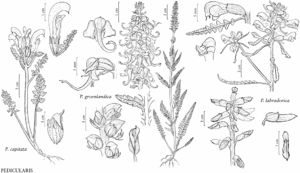Pedicularis groenlandica
Fl. Scand. Prodr. ed. 2, 145. 1795.
Plants 10–60 cm. Leaves: basal 5–20, blade lanceolate, 20–150 x 5–25 mm, 1-pinnatifid or slightly 2-pinnatifid, margins of adjacent lobes nonoverlapping, 1- or 2-serrate, surfaces glabrous; cauline 3–31, blade lanceolate, 10–150 x 1–25 mm, 1-pinnatifid, margins of adjacent lobes nonoverlapping, serrate, surfaces glabrous. Racemes simple, 1 or 2, exceeding basal leaves, each 20–75-flowered; bracts linear to trullate, 5–10 x 2–10 mm, undivided to pinnatifid, margins entire, serrate, or 2-serrate, surfaces glabrous. Pedicels 0.5–1 mm. Flowers: calyx 3–5 mm, glabrous or hispid, lobes 5, deltate, 0.5–1.5 mm, apex entire, glabrous; corolla 5–8 mm, tube purple, rarely white, 3–5 mm; galea pink to purple, rarely white, 1.5–3 mm, beaked, beak coiled, 5–18 mm, base curving, margins entire medially and distally, apex not surrounded by abaxial lip, axis of coil nearly horizontal; abaxial lip pendulous, purple, rarely white, 2–5 mm. 2n = 16.
Phenology: Flowering Jun–Sep.
Habitat: Montane and alpine to arctic bogs, fens, marshes, and forested swamps, seepage areas, stream banks, fens, clay gravel flood plains of rivers.
Elevation: 600–3500 m.
Distribution
Greenland, Alta., B.C., Man., Nfld. and Labr. (Labr.), Nunavut, Ont., Que., Sask., Yukon, Alaska, Ariz., Calif., Colo., Idaho, Mont., Nev., N.Mex., Oreg., Utah, Wash., Wyo.
Discussion
Pedicularis groenlandica has a domed galea, a long, curved beak, and relatively large lateral lobes of the abaxial lip that remarkably resemble the head, trunk, and ears of an elephant. Pedicularis groenlandica is the most widely distributed Pedicularis species in North America; it occurs from the southern Sierra Nevada and southern Rocky Mountains well into the Arctic and Greenland.
Pedicularis attollens and P. groenlandica are sympatric in the Sierra Nevada and the Cascades of central and southern Oregon and can be difficult to distinguish. Pedicularis groenlandica is distinguished by the size and orientation of the beak and color of the corolla; the beak is over twice the length of the beak of P. attollens and is oriented more horizontally compared to the upturned beak of P. attollens. Beak orientation is very difficult to ascertain in herbarium material due to flattening; beak length is a better character on herbarium specimens. The corollas of P. groenlandica are purple with lighter purple to pinkish abaxial lips, whereas the corollas of P. attollens vary from pink to light pink often with conspicuous dark purple spots on the galeas. White-flowered forms of P. groenlandica (forma pallida Lepage) are occasionally seen.
Selected References
None.
